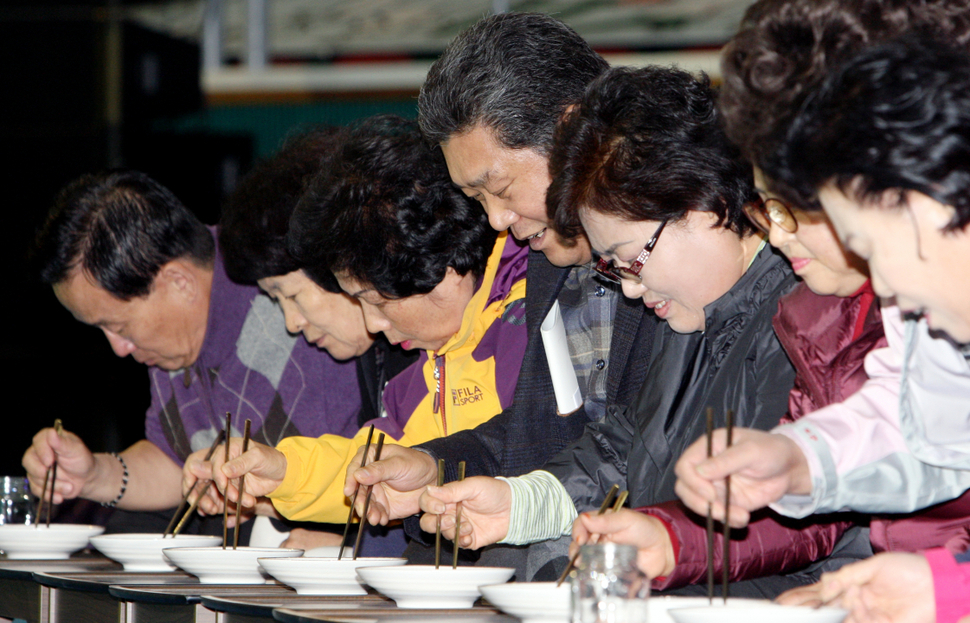Posted on : Nov.10,2016 16:02 KST
Modified on : Nov.10,2016 16:29 KST
People in all three countries use chopsticks at every meal, but each culture has its unique aspects
 |
|
Participants use chopsticks to move beans during a competition at the Chopstick Festival in Cheongju, North Chungcheong Province. (provided by Cheongju City Hall) Chopstick experts from Korea, China and Japan look at various kinds of chopsticks at Mabul Gallery in Cheongju, North Chungcheong Province. (provided by Cheongju City Hall)
|
What is the cultural code that links Korea, China and Japan?
The Cheongju Cultural Industry Promotion Foundation in North Chungcheong Province suggested that chopsticks are a cultural icon of Korea, China and Japan, which have been neighbors for more than 2,000 years. One third of the world eats with a fork, one third with chopsticks and one third with their hands. Korea, China and Japan have led the way in chopstick culture and will do so in the future, the foundation says.
The foundation announced on Nov. 9 that it would be holding a chopstick festival at the old Cheongju Tobacco Factory and other sites from Nov. 10 to 27. Whereas the first festival, held last year, was significant because of the pronouncement of Nov. 11 as “chopstick day,” the second festival will be a festival to share chopstick culture.
First, festivalgoers will be offered a close look at chopstick culture in Korea, China and Japan, including the unique aspects of chopstick culture in the three countries. Korea will be represented by chopsticks that were painstakingly prepared by craftspeople including Kim Seong-ho (lacquerwork), Lee Jong-guk (ash wood carving), Yu Pil-mu (calligraphy brushes) and Park Gap-sul (brassware). These craftspeople have made a hit by creating chopsticks that are cultural products, pulling in revenue of more than 100 million won (US$86,700) this year alone.
More than 3,000 items related to chopsticks will be on display, including more than 200 pairs of chopsticks from Taketo Uratani (president of Hyozaemon, Japan’s largest chopstick manufacturer) and more than 100 pairs of chopsticks by Chinese chopstick craftsman Liu Hongxin. The festival will also provide an opportunity to encounter culinary culture, including earthenware and small dining tables called
soban, as well as clothing and accessories from the three countries.
“Chinese chopsticks, called ‘kuazi,’ were designed to be big and convenient, while Japanese chopsticks, called ‘hashi,’ were revered so much that couples would exchange them when they got married. Koreans used chopsticks along with a spoon and regarded them as a part of their body,” said Byeon Gwang-seop, head of the foundation’s creative economy team.
“The cultures of these three countries - which are at once so similar and yet different - also can be seen through their chopsticks,” Byeon said.
There will also be a competition for chopstick gurus and prodigies (more than 10,000 people participated in the qualifying rounds); a chopstick lecture by Hisatsugu Nakamichi, a professional educator about Japanese chopsticks; and an academic conference about chopstick culture featuring luminaries such as Xue Hualong, chair of the Shanghai Society for the Promotion of Chopsticks. These figures are also planning to discuss the idea of asking UNESCO to add chopsticks to its list of world cultural heritages.
“We‘ve held this festival so that the global community can be united under chopsticks, which are a fundamental part of Asian culture,” said Lee Seung-hoon, mayor of Cheongju.
By Oh Yoon-joo, Cheingju correspondent
Please direct questions or comments to [english@hani.co.kr]









